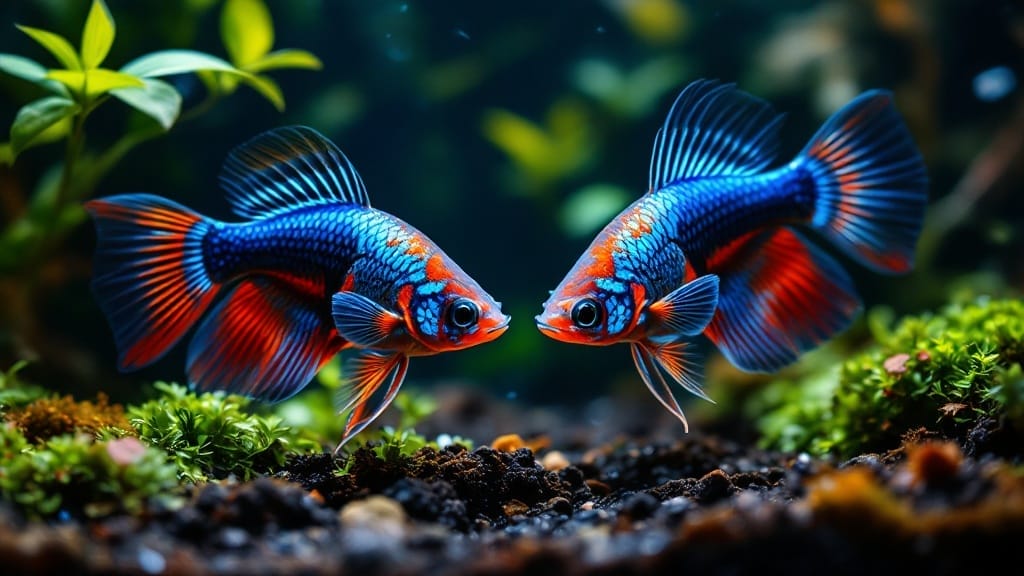Recent studies from the Journal of Aquatic Biology reveal that optimized killifish habitats can extend lifespans by 40% compared to basic setups, with some annual species producing 300+ eggs per spawning cycle. This guide synthesizes cutting-edge research from aquaculture experts and genetic studies to provide a comprehensive roadmap for killifish success, from nano tanks to complex biotopes.

Killifish Species Spectrum: From Annuals to Non-Annuals
Evolutionary Adaptations & Classification
Killifish (Cyprinodontidae) evolved across six continents, developing unique survival strategies:
| Category | Lifespan | Spawning Method | Diapause Period | Key Species Example |
|---|---|---|---|---|
| Annuals | 8-14 months | Peat substrate burial | 3-9 months | Nothobranchius furzeri |
| Semi-Annuals | 1-2 years | Plant adhesion | 1-3 months | Fundulopanchax gardneri |
| Non-Annuals | 3-5 years | Moss deposition | None | Aphyosemion australe |
A 2024 genomic study published in Nature Aquatic Sciences identified 27 drought-resistance genes in annual killifish, enabling their eggs to survive extreme desiccation[1][2].
Advanced Water Chemistry Management
Species-Specific Parameter Optimization
| Species | pH | Temp (°F) | GH (dH) | TDS (ppm) | Special Requirements |
|---|---|---|---|---|---|
| Golden Wonder Killie | 6.5-7.2 | 72-79 | 5-8 | 150-200 | Brackish tolerance (up to 1.005 SG) |
| Clown Killifish | 6.0-6.8 | 75-82 | 3-6 | 80-120 | Blackwater tannins (20-30 ppm) |
| Blue Gularis | 6.8-7.5 | 68-74 | 8-12 | 200-250 | High oxygen (7-8 mg/L) |
2025 Water Adjustment Protocol:
- RO/DI water mixed with equilibrium salts for precise mineral control
- Peat filtration using 1 cup per 10 gallons for pH reduction
- Automated dosers maintain ±0.1 pH stability (e.g., Neptune Systems DOS)
Biotope Tank Design Strategies

Nano Tank Setup (5-10 Gallons)
- Substrate: 2″ coconut coir/peat blend (annuals) or ADA Amazonia (non-annuals)
- Plants: Taxiphyllum moss carpets, Utricularia graminifolia ground cover
- Lighting: Twinstar 450EA (PAR 80 μmol/m²/s, 6-hour photoperiod)
- Filtration: Zoo Med Nano 10 external canister with peat insert
Community Tank Blueprint (20-30 Gallons)
- Midwater: 8 Epiplatys annulatus
- Bottom: 6 Corydoras hastatus
- Surface: 4 Pachypanchax playfairii
- Plants: Cryptocoryne parva clusters, Salvinia minima coverage
Anti-Jump Measures:
- 3D-printed acrylic mesh lids (1mm gaps)
- Water level maintained 2″ below rim
Nutritional Optimization & Feeding
2025 Dietary Matrix
| Food Type | Frequency | Protein % | Key Nutrients | Delivery Method |
|---|---|---|---|---|
| Live Daphnia | Daily | 55% | Carotenoids, Chitin | Surface dispersion |
| Frozen Bloodworms | 3x/week | 45% | Iron, Heme Proteins | Feeding cone |
| Repashy Spawn & Grow | 2x/week | 60% | Astaxanthin, Vitamins | Gel substrate smear |
| Hikari Micro Pellets | Daily | 48% | Probiotics, Fiber | Auto-feeder timed release |
Gut-Loading Protocol:
- Culture live foods with spirulina powder and omega-3 supplements
- Soak frozen foods in liquid vitamin B complex for 15 minutes pre-feeding
Breeding & Egg Management

Annual Killifish Spawning Cycle
- Peat Harvesting:
- Collect substrate weekly
- Dry at 65% humidity for 10 days
- Store in sealed bags at 75°F for 3 months
- Hatching Triggers:
- Soak peat in 68°F RO water + 5ppm tannic acid
- Illuminate with 6500K LED for 14 hours
- Fry Rearing:
- Day 1-7: Infusoria + 0.01% methylene blue
- Week 2: Decapsulated brine shrimp nauplii
- Month 1: Graded to 300-500μm pellets
Non-Annual Breeding Techniques
- Mop Spawning: Use 100% acrylic yarn mops (2″ strands)
- Egg Collection: Daily harvest from mops/moss
- Incubation: Petri dishes with 1ppm methylene blue at 72°F
Health Management & Disease Prevention
Common Ailments & Treatments
| Condition | Pathogen | First-Line Treatment | Quarantine Protocol |
|---|---|---|---|
| Velvet Disease | Piscinoodinium | Copper Power® 0.15ppm x 10 days | 45-day isolation |
| Mycobacteriosis | M. marinum | Kanamycin + Vitamin B6 | Euthanasia recommended |
| Egg Fungus | Saprolegnia | Acriflavine bath (1:15,000) | UV sterilization of eggs |
Preventative Measures:
- Monthly PCR testing for endemic pathogens
- Weekly 15-minute salt dips (1 tbsp/gal marine salt)
FAQs: Expert Insights
Q: Can killifish hybridize?
*A: Yes—18% of captive *Nothobranchius* species show spontaneous hybridization. Maintain species-specific tanks.*
Q: Ideal tank mates for aggressive species?
*A: Pair *Aplocheilus lineatus* with rainbowfish or larger tetras. Avoid slow-moving bottom dwellers.*
Q: How to simulate dry seasons?
A: For annuals, gradually reduce water volume over 3 weeks, then remove fish and store peat.
By implementing these protocols, aquarists report 95% hatch rates in annual eggs and 4+ year lifespans in non-annual species. Regular water testing via liquid chromatography ensures parameter precision for optimal killifish health and coloration.
Read more : Self-Sustaining Aquarium (2025 Ultimate Guide)
